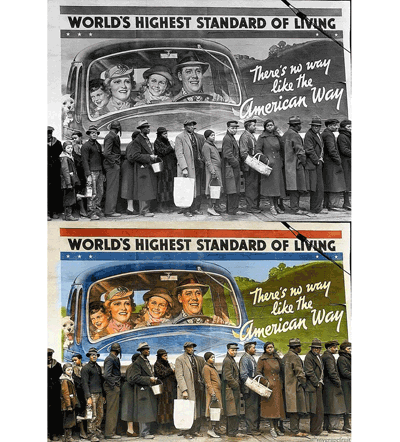
Margaret Bourke-White's 1937 Bread Line during the Louisville Flood. All images colorized by Sanna Dullaway.
This week, Sanna Dullaway’s colorized versions of famous historic photographs went viral on the Internet, drawing both admiration and alarm. Dullaway had picked some truly iconic photographs to colorize, from Dorothea Lange’s Migrant Mother to Eddie Adams’ famous shot of a Vietnamese general executing a Vietcong prisoner during the opening stages of the Tet Offensive. The young Swede (who has just launched a business colorizing old family snapshots) displayed these color versions side-by-side with the originals. Suddenly, figures and scenes long burned into our minds in their original black-and-white incarnations were popping out in glorious color—rusty reds, rich golds, the blue of cornflowers and irises. The images spread quickly on news sites and Facebook feeds—and then some people got mad.
“A parasitical one trick pony grazing on the shoulders of giants,” Dullaway was called in one Facebook photography thread, while someone else excoriated her for “coloring that like a coloring book.” “Sickening” and “inexcusable” were other adjectives thrown out. Some were more generous, admiring Dullaway’s technique and color choices, and writing that it had given them a new appreciation of the original work.
I was intrigued by this response, and by the protectiveness people felt toward these images. Personally I found them fascinating, and not confusing or deceptive since they were printed side-by-side with the original black-and-whites.




 Facebook
Facebook Permalink
Permalink Digg
Digg Reddit
Reddit LinkedIn
LinkedIn StumbleUpon
StumbleUpon Tumblr
Tumblr

